
The genus Argiope includes rather large spiders that often have a strikingly coloured abdomen. These spiders are distributed throughout the world. Most countries in tropical or temperate climates host one or more species that are similar in appearance. The etymology of Argiope is from a Latin word argentum meaning silver. The carapace of Argiope species is typically covered in silvery hairs, and when crawling in the sun, they reflect it in a way that gives them a metallic, white appearance.

Orb-weaver spiders are members of the spider family Araneidae. They are the most common group of builders of spiral wheel-shaped webs often found in gardens, fields, and forests. The English word "orb" can mean "circular", hence the English name of the group. Araneids have eight similar eyes, hairy or spiny legs, and no stridulating organs.

Gasteracantha is a genus of orb-weaver spiders first named by Carl Jakob Sundevall in 1833. Species of the genus are known as spiny-backed orb-weavers, spiny orb-weavers, or spiny spiders. The females of most species are brightly colored with six prominent spines on their broad, hardened, shell-like abdomens. The name Gasteracantha is derived from the Greek gaster (γαστήρ), meaning "belly, abdomen", and akantha (άκανθα), meaning "thorn, spine". Spiny-backed orb-weavers are sometimes colloquially called "crab spiders" because of their shape, but they are not closely related to the true crab spiders. Other colloquial names for certain species include thorn spider, star spider, kite spider, or jewel spider.

Nephila is a genus of araneomorph spiders noted for the impressive webs they weave. Nephila consists of numerous species found in warmer regions around the world, although some species formerly included in the genus have been moved to Trichonephila. They are commonly called golden silk orb-weavers, golden orb-weavers, giant wood spiders, or banana spiders.
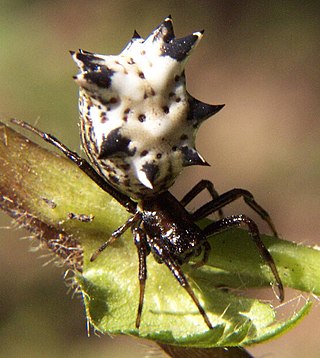
Micrathena gracilis is a spider in the family Araneidae (orb-weavers), commonly known as the spined micrathena or castleback orbweaver. This spider spins a moderately large and very tightly coiled web. The spiders themselves are small and can be found to be anywhere from 4.2 mm to 10.8 mm long. Its venom is harmless to humans. M. gracilis is unique in appearance due to its large spiky abdomen and black and white bodies. Certain spiders of this species can also display a yellow color on the sides of their bodies. These spiders can be seen most active during the end of the summer and beginning of fall. M. gracilis is diurnal and are rarely ever seen active at night.

Trichonephila inaurata, synonym Nephila inaurata, commonly known as the red-legged golden orb-weaver spider or red-legged nephila, is a species of spider of the genus Trichonephila. It is native to southern and East Africa, as well as several islands of the western Indian Ocean.
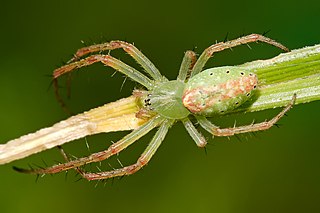
Cyrtophora, the tent-web spiders, is a genus of orb-weaver spiders first described by Eugène Simon in 1895. Although they are in the "orb weaver" family, they do not build orb webs. Their tent-like, highly complex non-sticky web is sometimes considered a precursor of the simplified orb web. These webs are aligned horizontally, with a network of supporting threads above them. These spiders often live in colonies. Females have a body length of mostly about 10 millimetres (0.39 in) long. Some members, including Cyrtophora cicatrosa, exhibit the ability to change colour rapidly.
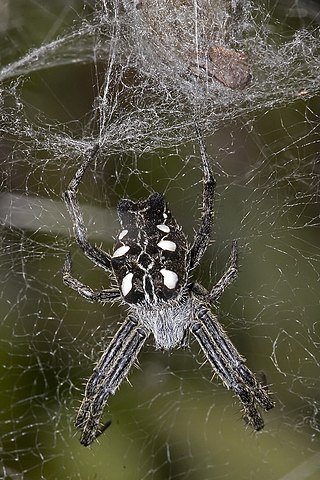
Cyrtophora citricola, also known as the tropical tent-web spider, is an orb-weaver spider in the family Araneidae. It is found in Asia, Africa, Australia, Costa Rica, Hispaniola, Colombia, and Southern Europe and in 2000, it was discovered in Florida. C. citricola differs from many of its close relatives due its ability to live in a wide variety of environments. In North America and South America, the spider has caused extensive damage to agricultural operations.

Argiope catenulata, also known as the grass cross spider, is a species of orb-weaver spiders ranging from India to the Philippines and Papua New Guinea, and also found in Australia in 2019. Like other species of the same genus, it builds a web with a zig-zag stabilimentum.

Cyrtophora exanthematica are tent spiders common in tropical Asia and Australia. They are commonly known as double-tailed tent spiders because of the pair of blunt projections at the end of their abdomens. They are harmless to humans.
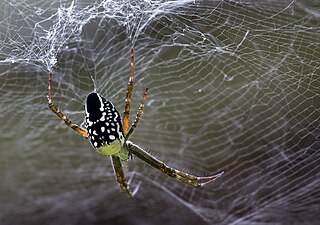
Cyrtophorinae is a subfamily of spiders in the orb-weaver spider family. Unlike other orb-weavers, spiders belonging to Cyrtophorinae build horizontal, finely meshed platforms within a tangle of irregular webs. The usually dome-shaped platform is a non-sticky orb web.

Cyrtophora parangexanthematica is a species of tent spider found in the Philippines. Its scientific name comes from its close resemblance to double-tailed tent spiders. It was described from a single female specimen collected in 1995.

Cyrtophora unicolor is a species of spider of the family Araneidae. It is known as the red tent spider.
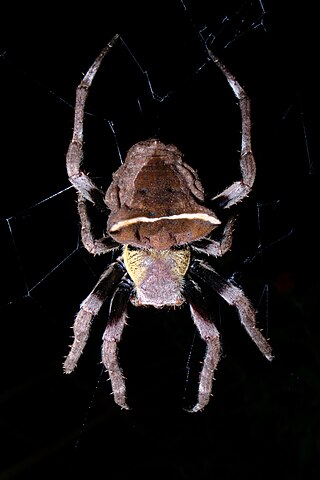
Parawixia dehaani, known in Australia as the abandoned-web orb-weaver, is a species of orb weaver spider from the family Araneidae which is widely distributed in Australasia and eastern Asia. It is common in gardens, leading to it sometimes being known by the name common garden spider. The specific name is sometimes spelt dehaanii.
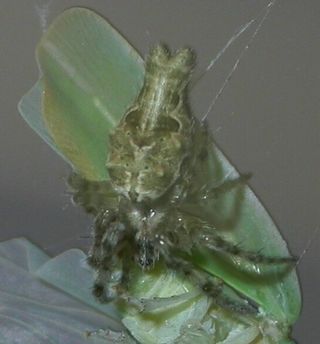
Allocyclosa is a genus of orb weaver spiders that contains only one species, Allocyclosa bifurca. It was first described in 1887 by McCook under the name Cyrtophora bifurca, and was transferred to its own genus in 1999. It is the only Cyclosa species north of Mexico to have a forked tail, hence the name bifurca, Latin for "two-forked". The forked abdomen, bearing two humps shaped like the letter M, is a defining feature in both males and females, though it is similar to features present in certain Cyrtophora species. Both sexes are a transparent green color, though only females have an area of red on their underside between the epigynum and the spinnerets. Females are nearly thirty percent larger than males, ranging from five to nine millimeters, while males range from two to three millimeters. Males are very uncommon. In a 1977 study by Levi, only two of the nearly 350 specimens that were positively identified as Cyrtophora bifurca were males. This is a very odd distribution, and it has been posed that females of the species, which have less prominent genitalia relative to other members of the orb-weaver family, may be parthenogenic, or able to reproduce without the help of males. Like other members of Araneidae, these spiders create orb webs, six to eight inches in diameter, but apply a unique form of protective mimicry. Females sit in the middle of a vertical row of web decoration, with egg sacs above and wrapped prey below. Because they all have a similar color and shape, it is difficult to discern between the egg sacs, the wrapped prey, and the spider itself.

Leucauge mariana is a long-jawed orb weaver spider, native to Central America and South America. Its web building and sexual behavior have been studied extensively. Males perform several kinds of courtship behavior to induce females to copulate and to use their sperm.
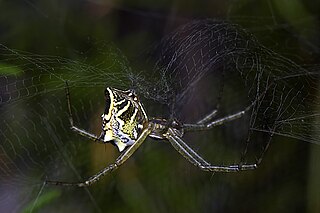
Cyrtophora cicatrosa, commonly known as the garden tent-web spider or dome spider, is a common species of orb-weavers found in many parts of Asia. It is common in gardens and has a very dense, thick, three dimensional and strong tent-like web.

Cyrtarachne nagasakiensis is a species of spider in the orb-weaver spider family Araneidae, found in Pakistan, India, China, Korea and Japan. Spiders in the genus Cyrtarachne construct "spanning-thread webs" rather than the more typical orb webs of the family Araneidae. These webs have a small number of radii and instead of a tight spiral of sticky threads, the sticky spanning threads are widely spaced and do not form a spiral. When prey is caught on one of the spanning threads, one end comes loose, and the prey, often a moth, dangles from the other end until hauled in by the spider.

Cyrtarachne yunoharuensis is a species of spider in the orb-weaver spider family Araneidae, found in China, Korea and Japan. Spiders in the genus Cyrtarachne construct "spanning-thread webs" rather than the more typical orb webs of the family Araneidae. These webs have a small number of radii and instead of a tight spiral of sticky threads, the sticky spanning threads are widely spaced and do not form a spiral. When prey is caught on one of the spanning threads, one end comes loose, and the prey, often a moth, dangles from the other end until hauled in by the spider.























